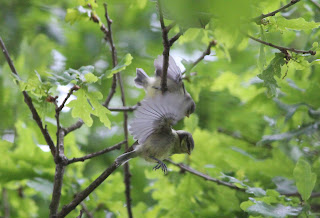Determined Lapwing & A Wild Goose Chase!
Peewit, Lapwing, Green Plover, Vanellus vanellus, whatever you call them, they're in big population decline here in the UK. I'm a scientist, so here's a graph showing the data from BTO that proves it (y axis is a smoothed population index & green indicates 85% confidence limits).
Origins of the Lapwing name hail from Middle English lappewinke and lapwyngis, and back even earlier to the Old English hleapewince, all of which mean 'leap' and 'wince' or 'waver, move rapidly'. It's descriptive, as the Lapwing appear to make a big leap when they take to the air, and when on the ground they scuttle about quite rapidly. In that respect I'd hardly call them wavering, as I shall highlight below. However, when they're foraging they pause to listen, and patter on the mud using a foot, which increases their success rate in finding and catching invertebrates.
The distinctive calls of peewit, or kievit, if the Dutch birds (explains some of their other names) ever made the short hop across the North Sea, can be heard as soon as you reach the marshes particularly in the spring. This is usually accompanied by some tumbling, turning, swooping and even upside down flying. How do they do that? If you haven't watched the aerial acrobatics of these amazing birds, then you have missed out on nature's very own Cirque du Soleil show.
The decline in population isn't for lack of trying on their part. I was recently up on the North Norfolk coast at NWT Cley watching the Lapwing and their young families on Arnold's Marsh. They are determined birds when protecting their patch of marsh, be it from other lapwing or other bird species, many of which can be much, much bigger than themselves. They'll even take on the top avian predator of the marshland, the Marsh Harrier, and like most birds in the breeding season, have absolutely zero tolerance of crows and gulls. Mob-handed they take them on in mid air, trying to stall the perceived intruder's flight, or dive bombing anything on the ground. All intended to distract from nests and the precious bundles of fluff running among the grass tussocks.
However I was quite surprised when I saw just one female take on half a dozen Greylag that were meandering too close to her four babies. That saying about geese being the best guards, just got upgraded to Lapwing. This was a proper wild goose chase except there was real purpose in it, to keep those big, and as far as Mrs Lapwing was concerned, clumsy, birds off of her newly hatched babies.
When a Lapwing hatches it seems to have the ability to run instantly, which is probably a good thing as on grazing marshes (prime Lapwing Real Estate) there are often even bigger beasts to avoid, like cows. It's worth noting in this 400th anniversary year of Shakespeare, that he refers to them in Hamlet, when Horatio says of Osric "This lapwing runs away with the shell on his head." It's as if they can't wait to be hatched and are eager to get on with life, forward little chaps. I have to say I have never seen one with shell on its head though!
Lapwing get another mention in Comedy of Errors, this time referring to their habit of luring predators away from nests "Far from her nest the lapwing cries away." This deception is carried out with cries and/or feigning injury and in fact explains another name. The Greek name used to be polyplagktos meaning "luring on deceitfully." Other writers have noted this behaviour, consequently the Lapwing has sadly become a symbol of deceit and insincerity. I say, it is only trying to survive in a tough environment.
So what are we doing to try to help these birds, they clearly do their very best to help themselves? I take part in the RSPB's Lowland Farmland Breeding Wader Survey (yes a right mouthful), along with other survey volunteers, and farmers who are managing their land in a way to support several dramatically declining species. I survey a farm each year in the Broads, I'm over on Halvergate this year. It's glorious out there (when the weather is kind), and I'm so pleased to hear the news that the RSPB have managed to acquire more land in this internationally important area. The target birds we surveyors are looking for are not just Lapwing, but also Curlew, Redshank, Oystercatcher, Snipe and Yellow Wagtail (technically not a wader but likes the wetlands!). The participating farmers in this partnership have been given advice about managing the degree of wet in their fields, and the amount of rush allowed to grow based on previous work by the RSPB. They are encouraged to scrape out foot drains (shallow 'ditches' containing water no more than ankle deep) and can use their cattle and sheep, but at not too high densities, to create areas of shorter sward. All of which provides soft mud into which long-beaked waders can probe for insects, worms, etc., especially important for chicks, and a variety of different vegetation lengths, and clumps of rush to provide cover from predators. Time, and surveys, will tell if these subtle management changes will make a difference, I really hope so!
What a tragedy it would be if we lost these beautiful and boisterous birds of coast and marsh. My favourite places for easy viewing of these birds all year round (and in large numbers in winter) are: NWT Cley or Hickling, and RSPB Buckenham Marshes, but really any field that's a bit damp and where the grass isn't too long.
Pause a while to watch and listen but remember, it's their marsh in spring, so don't get too close!
 |
| Adult Lapwing showing off gorgeous feather colours & a jaunty crest. |
Origins of the Lapwing name hail from Middle English lappewinke and lapwyngis, and back even earlier to the Old English hleapewince, all of which mean 'leap' and 'wince' or 'waver, move rapidly'. It's descriptive, as the Lapwing appear to make a big leap when they take to the air, and when on the ground they scuttle about quite rapidly. In that respect I'd hardly call them wavering, as I shall highlight below. However, when they're foraging they pause to listen, and patter on the mud using a foot, which increases their success rate in finding and catching invertebrates.
 |
| Pausing to patter, best foot forward. |
 |
| Aerial acrobatics. |
 |
| Almost upside down. |
The decline in population isn't for lack of trying on their part. I was recently up on the North Norfolk coast at NWT Cley watching the Lapwing and their young families on Arnold's Marsh. They are determined birds when protecting their patch of marsh, be it from other lapwing or other bird species, many of which can be much, much bigger than themselves. They'll even take on the top avian predator of the marshland, the Marsh Harrier, and like most birds in the breeding season, have absolutely zero tolerance of crows and gulls. Mob-handed they take them on in mid air, trying to stall the perceived intruder's flight, or dive bombing anything on the ground. All intended to distract from nests and the precious bundles of fluff running among the grass tussocks.
 |
| Eyeing each other. |
 |
| Duelling for a patch of marsh to breed in. |
 |
| Contact! |
 |
| Commencing a dive bomb - zero tolerance of crows! |
 |
| Taking on a Marsh Harrier! |
However I was quite surprised when I saw just one female take on half a dozen Greylag that were meandering too close to her four babies. That saying about geese being the best guards, just got upgraded to Lapwing. This was a proper wild goose chase except there was real purpose in it, to keep those big, and as far as Mrs Lapwing was concerned, clumsy, birds off of her newly hatched babies.
 |
| Wild Goose chase! |
 |
| Mum returns to chicks & calm is restored, briefly. |
When a Lapwing hatches it seems to have the ability to run instantly, which is probably a good thing as on grazing marshes (prime Lapwing Real Estate) there are often even bigger beasts to avoid, like cows. It's worth noting in this 400th anniversary year of Shakespeare, that he refers to them in Hamlet, when Horatio says of Osric "This lapwing runs away with the shell on his head." It's as if they can't wait to be hatched and are eager to get on with life, forward little chaps. I have to say I have never seen one with shell on its head though!
 |
| Barely out of the egg & already on the move. |
 |
| Getting older & admiring the reflection. |
Lapwing get another mention in Comedy of Errors, this time referring to their habit of luring predators away from nests "Far from her nest the lapwing cries away." This deception is carried out with cries and/or feigning injury and in fact explains another name. The Greek name used to be polyplagktos meaning "luring on deceitfully." Other writers have noted this behaviour, consequently the Lapwing has sadly become a symbol of deceit and insincerity. I say, it is only trying to survive in a tough environment.
 |
| Crying loudly to distract me from the youngsters. |
So what are we doing to try to help these birds, they clearly do their very best to help themselves? I take part in the RSPB's Lowland Farmland Breeding Wader Survey (yes a right mouthful), along with other survey volunteers, and farmers who are managing their land in a way to support several dramatically declining species. I survey a farm each year in the Broads, I'm over on Halvergate this year. It's glorious out there (when the weather is kind), and I'm so pleased to hear the news that the RSPB have managed to acquire more land in this internationally important area. The target birds we surveyors are looking for are not just Lapwing, but also Curlew, Redshank, Oystercatcher, Snipe and Yellow Wagtail (technically not a wader but likes the wetlands!). The participating farmers in this partnership have been given advice about managing the degree of wet in their fields, and the amount of rush allowed to grow based on previous work by the RSPB. They are encouraged to scrape out foot drains (shallow 'ditches' containing water no more than ankle deep) and can use their cattle and sheep, but at not too high densities, to create areas of shorter sward. All of which provides soft mud into which long-beaked waders can probe for insects, worms, etc., especially important for chicks, and a variety of different vegetation lengths, and clumps of rush to provide cover from predators. Time, and surveys, will tell if these subtle management changes will make a difference, I really hope so!
 |
| Big flocks gather in winter. |
 |
| Off to roost in the autumn. |
What a tragedy it would be if we lost these beautiful and boisterous birds of coast and marsh. My favourite places for easy viewing of these birds all year round (and in large numbers in winter) are: NWT Cley or Hickling, and RSPB Buckenham Marshes, but really any field that's a bit damp and where the grass isn't too long.
Pause a while to watch and listen but remember, it's their marsh in spring, so don't get too close!



Update: European Bird Census shows a worrying 60% decline across the continent over the past 30 years. Some of the research (here in Norfolk) to understand why is described here:
ReplyDeletehttps://wadertales.wordpress.com/2015/10/14/a-helping-hand-for-lapwings/
Its an interesting read and hopefully some measures can be put in place as a result that will help Lapwing have more breeding success.